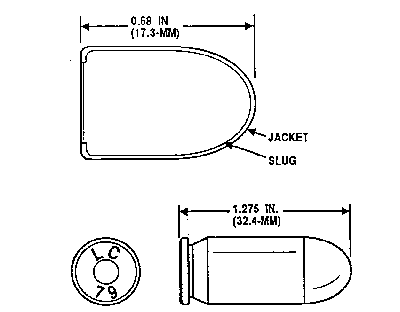



This cartridge is a current standard item of issue and is used in the automatic pistol, M1911 and M19llA1, the Colt revolver M 1917, the Smith and Wesson revolver M1917, and tile Thompson submachine gun M1928 and M 1928A1, against personnel. To adapt it for use in the revolvers, it must be assembled in clips designed for this purpose. The cartridge consists of the cartridge case, primer, propelling charge, and the bullet. The complete assembly weighs approximately 327 grains. The bullet has a round nose and a flat base. It consists of two parts, a gilding metal jacket and slug of lead hardened with antimony. In early designs bullet jackets were made of cupro-nickel and these have a silvery appearance. This was later changed to gilding metal which was given thin tin wash which has a close resemblance to the cupro-nickel jacket. The practice of tinning the jackets has since been discontinued and the bullets of current design have the natural copper color of gilding metal. The over-all length of the bullet is 0.68 inch. The mouth of the case may be crimped to the bullet and Ball, pull of approximately 40 pounds is required to remove the bullet from the case.
Use:
Submachine Gun, Caliber .45, M3A1, and Pistol, Caliber
.45, M1911A1.Description: The cartridge is identified by a plain bullet tip. Purpose: The cartridge is intended for use against
personnel.DODAC..... 1305-A475 Weight..... 331 grain Length..... 1.275 inch Propellant..... SR 7970 Weight..... 5 grain Reference TM 43-0001-27, June 1981 Exterior ballistics
Maximum range.- In pistol, 1,600 yards.
In submachine gun, 1,700 yards.
Presure.-14,000 pounds per square inch.
Velocity.-Pistol.-25.5 feet, 820 feet per second.
Muzzle, 825 feet per second.
Submachine gun.- At 25.5 feet, 885 feet per second.
At muzzle, 990 feet per second. Muzzle energy- 329 foot-pounds Ball, pistol.
383 foot-pounds in submachine gun.
Accuracy with muscle test.
Mean variations for several targets
Range Mean Radii Yards Inches 25 0.86 50 1.36 75 2.24
Penetration.-In white pine.
Range Depth Yards Inches 25 6.0 100 5.5 250 4.0
The penetration in moist loam at 25 yards is about 10 inches. The penetration in dry sand at 25 yards is about 8 inches.
Table of fire.
1 Drift id to the left. Based on a velocity of 800 feet per second, 25 feet from muzzle.
Range Time of flight Drop Deflectionm due
to drift1Yards Seconds Inches Inches 10 0.037 0.3 0.1 20 .75 1.1 .2 30 .113 2.4 .3 40 .151 4.4 .4 60 .229 9.9 .8 80 .308 18 1.3 100 .388 28 2.0
